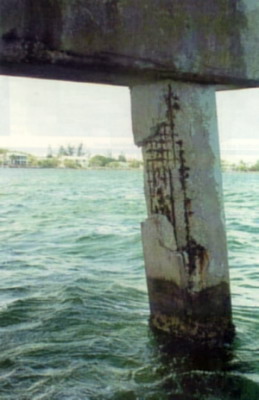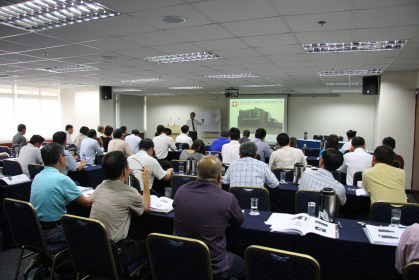|
 The corrosion of reinforcing steel in concrete structures such as
buildings, car parks, concrete marine structures, road beds, bridge
decks and bridge substructures is a world-wide problem and leads to
cracking, staining, spalling from the surface and ultimately structural
weakness. This 5-day advanced course thoroughly and systematically covers the
concrete durability issues: the causes of reinforcement corrosion,
common control and prevention methods for both old and new structures,
surveying and diagnosing techniques for condition assessment, the
conventional and some promising emerging technologies for repair and
rehabilitation of concrete structures. Participants will gain essential
knowledge and skills in managing corrosion in concrete structures.
Engineers, architects and designers will grasp the theories and
practices of corrosion control and prevention which would lead to
corrosion-proof designs and low cost durability. Participants will also
learn the principles and applications of advanced corrosion sensors and
monitoring systems for life prediction, repair and rehabilitation,
surveying, diagnosis and condition assessment. Facility owners will
benefit from increased durability, enhanced safety and reduced
maintenance costs. The corrosion of reinforcing steel in concrete structures such as
buildings, car parks, concrete marine structures, road beds, bridge
decks and bridge substructures is a world-wide problem and leads to
cracking, staining, spalling from the surface and ultimately structural
weakness. This 5-day advanced course thoroughly and systematically covers the
concrete durability issues: the causes of reinforcement corrosion,
common control and prevention methods for both old and new structures,
surveying and diagnosing techniques for condition assessment, the
conventional and some promising emerging technologies for repair and
rehabilitation of concrete structures. Participants will gain essential
knowledge and skills in managing corrosion in concrete structures.
Engineers, architects and designers will grasp the theories and
practices of corrosion control and prevention which would lead to
corrosion-proof designs and low cost durability. Participants will also
learn the principles and applications of advanced corrosion sensors and
monitoring systems for life prediction, repair and rehabilitation,
surveying, diagnosis and condition assessment. Facility owners will
benefit from increased durability, enhanced safety and reduced
maintenance costs.
This corrosion short course can be taken as in-house
training course, online course and distance learning course worldwide.
It can also be customized to meet the specific needs of your
organization.
|
|
1.
Corrosion and concrete durability
1.1
Impact of corrosion on society
1.2
Factors influencing concrete durability
2. Terminology and conventions
2.1 corrosion, pH, potential, reference electrode, potential-pH
diagram
2.2 passivation, passive rebar, depassivation, anode, cathode,
cathodic protection, galvanizing, carbonation, etc.
3. Why & How does rebar corrode in
concrete?
3.1
corrosion of steel in aqueous environment
3.2
the nature of concrete environment
3.3
corrosion of steel in concrete
3.4
actions from aggressive species chloride, carbon dioxide,
sulphate, soft water action
3.5
potential difference
3.6
corrosion reactions
3.7
ionic flow
3.8
autocatalytic process
3.9
Type of reinforcement corrosion: general/uniform, pitting,
concentration cells, differential aeration cells, galvanic cells, stray
current corrosion, microbiologically influenced corrosion (MIC)
4. How to control and prevent concrete
corrosion
4.1
concrete quality, porosity, permeability, depth of cover,
water/cement ratio, chloride content
4.2
patching practices
4.3
membranes and sealers
4.4
corrosion inhibitors
4.5
epoxy coating
4.6
galvanizing (zinc coating)
4.7
cathodic protection: principles of cathodic protection,
standards, criteria of protection, design of cathodic protection
systems, installation practices, operation and maintenance, testing and
monitoring
5. Surveying and diagnosing
5.1
Introduction: the need for survey and diagnosis
5.2
Non-destructive structural surveys
5.2.1
Visual and physical appraisal
5.2.2
Resistivity mapping: principles and data interpretation
5.2.3
ASTM C876 Half-Cell potential survey/mapping: principles and data
interpretation
5.2.4
Electrochemical techniques for corrosion rate measurements:
LPR, EIS, principles and data inpterpretation
5.2.5
Determining the remaining rebar diameter
5.2.6
Determining rebar condition: passive or depassivated,
polarization measurements
5.3
Depth of carbonation
5.4
Chloride contents
6. Testing and Monitoring
6.1
The Need for Corrosion Testing and Monitoring in Concrete
Structures
6.1.1
Assessment of the Extent of Corrosion Damage
6.1.2
Determing the Rate of Corrosion Damage
6.1.3
Early Warning -Monitoring the Rate of Corrosion Damage
6.1.4
Evaluating the Effectiveness of Repair/Rehabilitation
6.2
The Nature of Corrosion Process in Concrete Structures
6.2.1
Physical Changes Due to Corrosion
6.2.2
Chemical Changes Due to Corrosion
6.2.3
Corrosion Rate and Current Density
6.3
Indirect Methods for Corrosion Testing and Monitoring
6.3.1
Depth of carbonation
6.3.2
Depth of chloride penetration
6.3.3
Electrical resistance (ER probe)
6.3.4
Concrete resistivity
6.3.5
Half-cell potential mapping (ASTM standard C876)
6.3.6
pH, Temperature
6.3.7
Moisture
6.4
Direct Methods for Corrosion Testing and Monitoring
6.4.1
Linear polarisation resistance measurement
6.4.2
Potentiodynamic polarization
6.4.3
AC Impedance measurement
6.4.4
Electrochemical noise measurement
6.5
Design of Corrosion Sensors in Concrete Structures
6.5.1
Overview of sensor designs
6.5.2
Interfaces with sensors
6.5.3
Types of sensors
6.5.4
Principles of LPR-based sensors
6.5.5
Principles of ZRA-based sensors
6.5.6
Advantages and limitations
6.5.7
Monitoring system and components
6.5.8
The new generation of sensors for early warning and life
prediction
6.5.9
Cost considerations
7. Repair and
Rehabilitation
7.1
Corrosion and concrete durability
7.2
Factors influencing corrosion of reinforcement in concrete
structures
7.3
Conventional methods of concrete repair/rehabilitation
7.3.1
patch repair and the incipient anode effect
7.3.2
membranes and sealers
7.3.3
corrosion inhibitors
7.3.4
epoxy coating
7.3.5
galvanizing
7.4
Innovative Cathodic Protection Systems for Concrete Repair and
Rehabilitation
7.4.1
Principles of cathodic protection
7.4.2
Sacrificial anode CP
7.4.3
Pressure-sensitive Zinc-Hydrogel anode
7.4.4
Snap-on zinc mesh anode CP system
7.4.5
Impressed current CP
7.4.6
Anode design
7.4.7
Electrodes selection
7.4.8
Installation
7.4.9
Life expectancy and calculations
7.4.10
Case study
7.4.11
Applications
7.5
Chloride Extraction For Concrete Repair and Rehabilitation
7.5.1
Principles of chloride extraction
7.5.2
System setup and operating parameters
7.5.3
Assessment of effectiveness
7.5.4
Applications
7.6
Electrochemical Realkalisation For Concrete Repair and
Rehabilitation
7.6.1
Principles of electrochemical realkalisation
7.6.2
System setup and operating parameters
7.6.3
Assessment of effectiveness
7.6.4
Applications
7.7
Conductive Concrete
7.7.1
The nature of conductive concrete
7.7.2
Conductive concrete in cathodic protection
7.7.3
Case studies
7.7.4
Applications
7.8
Stainless Steels and Alloys Reinforcements
7.8.1
The fundamental difference between black rebar and stainless
steel rebar
7.8.2
Type of stainless steels and alloys
7.8.3
Mechanical properties of stainless steels and alloys
7.8.4
Corrosion resistance of stainless steels and alloys
7.8.5
Cost comparison
7.8.6
Case studies
7.8.7
Applications
7.9
Ranking of The Emerging Technologies For Corrosion Control In
Concrete Structures
7.10
Techniques to monitor the effectiveness of repair/rehab
strategies
|
|
 If you are concerned with corrosion in your
business, in-house training or on-site training is a great solution to train a group of
employees from design, production, operation, quality assurance, inspection
and maintenance, and technical sales and support on corrosion control and
corrosion prevention technology. The contents of all our corrosion courses can
be customized to fit your organization's needs.
If you are concerned with corrosion in your
business, in-house training or on-site training is a great solution to train a group of
employees from design, production, operation, quality assurance, inspection
and maintenance, and technical sales and support on corrosion control and
corrosion prevention technology. The contents of all our corrosion courses can
be customized to fit your organization's needs.
There is no limit to the number of
participants required for in-house training corrosion courses or on-site
training corrosion courses. We conduct the in-house or on-site
training corrosion courses at your company's premises worldwide and at a
time convenient to your company.
Click
here to contact us
for a quotation. |
|
 All our corrosion short courses are available for online or offline
distance learning. You can start an online course at any time and learn
at your own comfortable pace, whenever and wherever you are. You have
around-the-clock access to interactive and media-rich course materials,
virtual labs, course instructions, course assignments, and course
assessments. Discussions and questions related to the corrosion courses
are posted on the website or exchanged through email for a period up to
12 months. Video conferencing or instant messaging can also be arranged
for discussions of course topics. For those who do not have ready access
to internet, we can send you our online course materials on a CD-ROM or
DVD or USB memory stick for offline learning.
All our corrosion short courses are available for online or offline
distance learning. You can start an online course at any time and learn
at your own comfortable pace, whenever and wherever you are. You have
around-the-clock access to interactive and media-rich course materials,
virtual labs, course instructions, course assignments, and course
assessments. Discussions and questions related to the corrosion courses
are posted on the website or exchanged through email for a period up to
12 months. Video conferencing or instant messaging can also be arranged
for discussions of course topics. For those who do not have ready access
to internet, we can send you our online course materials on a CD-ROM or
DVD or USB memory stick for offline learning.
Click
here to register this
corrosion short course for online or distance learning. |
|
If you are involved in teaching or
training, you may wish to purchase a complete set of the trainer's
package for this training course. The trainer's
package comes complete with ready-to-use PowerPoint slides (fully
editable) and test bank (with answer keys). These ready-to-use
PowerPoint slides contain high quality color photographs, illustrations,
animations, audio and video clips. The test bank contains questions
conveniently grouped into four categories: (1) true or false, (2)
multiple choice, (3) calculation, and (4) reasoning and open-ended
discussions. The trainer's package is suitable for in-house training and
university teaching (30 lecture hours). This is exactly the same package that WebCorr uses to deliver our
current training course.
The one-time lump sum fee allows your
organization to use the training package and also modify it. For
example, your organization may modify the course contents and
re-name/re-brand the course under your organizationís name. WebCorr only
retains the copyright of the original PowerPoint slides and test banks.
Click
here to contact us if you need more information on the trainer's package. |
 The corrosion of reinforcing steel in concrete structures such as
buildings, car parks, concrete marine structures, road beds, bridge
decks and bridge substructures is a world-wide problem and leads to
cracking, staining, spalling from the surface and ultimately structural
weakness. This 5-day advanced course thoroughly and systematically covers the
concrete durability issues: the causes of reinforcement corrosion,
common control and prevention methods for both old and new structures,
surveying and diagnosing techniques for condition assessment, the
conventional and some promising emerging technologies for repair and
rehabilitation of concrete structures. Participants will gain essential
knowledge and skills in managing corrosion in concrete structures.
Engineers, architects and designers will grasp the theories and
practices of corrosion control and prevention which would lead to
corrosion-proof designs and low cost durability. Participants will also
learn the principles and applications of advanced corrosion sensors and
monitoring systems for life prediction, repair and rehabilitation,
surveying, diagnosis and condition assessment. Facility owners will
benefit from increased durability, enhanced safety and reduced
maintenance costs.
The corrosion of reinforcing steel in concrete structures such as
buildings, car parks, concrete marine structures, road beds, bridge
decks and bridge substructures is a world-wide problem and leads to
cracking, staining, spalling from the surface and ultimately structural
weakness. This 5-day advanced course thoroughly and systematically covers the
concrete durability issues: the causes of reinforcement corrosion,
common control and prevention methods for both old and new structures,
surveying and diagnosing techniques for condition assessment, the
conventional and some promising emerging technologies for repair and
rehabilitation of concrete structures. Participants will gain essential
knowledge and skills in managing corrosion in concrete structures.
Engineers, architects and designers will grasp the theories and
practices of corrosion control and prevention which would lead to
corrosion-proof designs and low cost durability. Participants will also
learn the principles and applications of advanced corrosion sensors and
monitoring systems for life prediction, repair and rehabilitation,
surveying, diagnosis and condition assessment. Facility owners will
benefit from increased durability, enhanced safety and reduced
maintenance costs. If you are concerned with corrosion in your
business, in-house training or on-site training is a great solution to train a group of
employees from design, production, operation, quality assurance, inspection
and maintenance, and technical sales and support on corrosion control and
corrosion prevention technology. The contents of all our corrosion courses can
be customized to fit your organization's needs.
If you are concerned with corrosion in your
business, in-house training or on-site training is a great solution to train a group of
employees from design, production, operation, quality assurance, inspection
and maintenance, and technical sales and support on corrosion control and
corrosion prevention technology. The contents of all our corrosion courses can
be customized to fit your organization's needs.

 All our corrosion short courses are available for online or offline
distance learning. You can start an online course at any time and learn
at your own comfortable pace, whenever and wherever you are. You have
around-the-clock access to interactive and media-rich course materials,
virtual labs, course instructions, course assignments, and course
assessments. Discussions and questions related to the corrosion courses
are posted on the website or exchanged through email for a period up to
12 months. Video conferencing or instant messaging can also be arranged
for discussions of course topics. For those who do not have ready access
to internet, we can send you our online course materials on a CD-ROM or
DVD or USB memory stick for offline learning.
All our corrosion short courses are available for online or offline
distance learning. You can start an online course at any time and learn
at your own comfortable pace, whenever and wherever you are. You have
around-the-clock access to interactive and media-rich course materials,
virtual labs, course instructions, course assignments, and course
assessments. Discussions and questions related to the corrosion courses
are posted on the website or exchanged through email for a period up to
12 months. Video conferencing or instant messaging can also be arranged
for discussions of course topics. For those who do not have ready access
to internet, we can send you our online course materials on a CD-ROM or
DVD or USB memory stick for offline learning. Webex
is hosted by Cisco, a product purpose-built for real-time web
communications. If you are an existing user of Webex, or if you are
willing to experience the power of Webex, we can conduct the course for you
over Webex with audio and video presentations and interactions with the
course instructor and other course attendees in real-time. It is just
like the physical classroom settings that everyone can interact with each
other. Your questions will be answered in real time by our instructor.
Webex
is hosted by Cisco, a product purpose-built for real-time web
communications. If you are an existing user of Webex, or if you are
willing to experience the power of Webex, we can conduct the course for you
over Webex with audio and video presentations and interactions with the
course instructor and other course attendees in real-time. It is just
like the physical classroom settings that everyone can interact with each
other. Your questions will be answered in real time by our instructor.